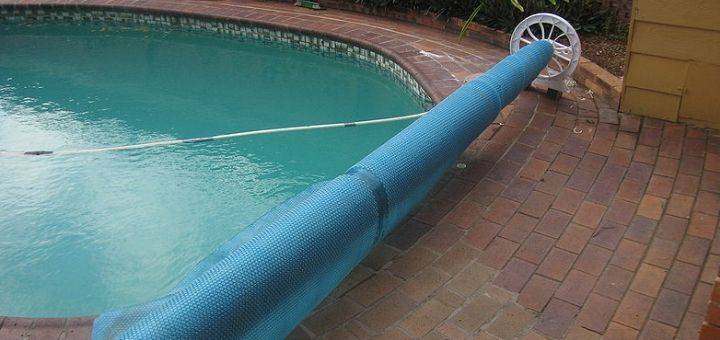If you are using a gas or electric heater to warm your above-ground pool water, then you need a solar cover. Solar pool covers will significantly save you money and energy consumption.
Most of the heat in the pool gets lost through the open surface. By covering the surface with a solar pool cover, you will effectively stop the heat loss.
When it involves buying above-ground pool covers, many covers get sold as a package and the retailers will add a very low-end cover to the deal. Because of this, there are many cheap pools covers out there that become brittle and decompose much sooner.
Getting a good quality solar cover will determine its ability of it to retain heat and also the length of life of the pool cover.
Best Solar Pool Cover Buying Tips
In this article, we will break down the best buying tips to look out for whenever you are shopping for a pool cover.
1. Best Type Solar Cover
Solar pool covers come in different types including:
Bubble Solar Covers
They are also known as solar blankets. They are covered with tiny sealed air bubbles which capture heat from the heater or the sun. They are lightweight, affordable, and energy-efficient solar covers.
Solar Rings
They are a smaller alternative to the bigger solar blanket with magnets on the rim. Compared to solar blankets, they are more expensive and less efficient because the entire surface isn’t covered. They are however easier to install.
Liquid solar covers
They are a chemical additive that creates a microscopic film on the surface of the pool, which acts as an insulator. The liquid is biodegradable. It breaks down over time therefore you will need to continue adding the liquid concentrate to replenish it.
Narrowing down on these three options, solar blankets are the most effective in conserving heat. It will cover your pool effectively eliminating evaporation better.
Eliminating evaporation is vital because if the water level drops below the height of the skimmers, your pump might suck in air which can hinder its proper functioning. But with an effective pool cover, water loss is reduced.
The covers are also UV protected which makes them also last longer. Without UV protection the cover would break down fast due to the sun’s radiation.
2. Best Solar Blanket Color
Solar blankets’ colors are most commonly blue, green, and clear covers.
The darker the cover pools’ color, the more heat they will attract and trap in the air bubble, and the faster they will transfer the heat to the water.
The lighter the cover the more light will pass through but will not trap the sun’s heat better. This might allow some UV light to pass through, thus degrading the water sanitizer.
Recommended: Solar Pool Cover for Above Ground Pool
3. Best Pool Cover Thickness
Solar pool covers come in 8 mm, 12 mm, and 16 mm.
8 mm solar covers
- Lowest price
- Lightweight
- Increases temp to 10 degrees ( F)
- 3-year warranty
12 mm solar covers
- Moderate price
- Medium thickness
- Increases temp to 15 degrees(F)
- 7-year warranty
16 mm solar covers
- Highest quality but reasonably priced
- Thickest cover
- Increases temp to 18 degrees (F)
- 8-year warranty.
From the look above, the 16 mm pool covers appear to do the job better and to last longer.
Most people, however, opt for the mid-range thickness because the major drawback to a thicker solar cover is that they are heavier and more cumbersome to move around.
4. Best Pool Cover Design
Common designs include;
-
Bubble Solar Cover
This design option looks like a large structure roll of tiny pockets of bubble wrap with air trapped inside them.
-
Straight Line Vinyl Cover
This is a sheet of thin straight-line material vinyl that floats on the surface of the pool.
-
Insulated Vinyl Cover
This design option is made from several layers of vinyl making it thicker. The thickness allows pockets of air in between the layers.
Of this pool design, the bubble solar cover is the most preferred due to its effectiveness and intricate design. This cover is designed to withstand hard sunlight all summer while remaining light and easy to handle.
5. Best Pool Cover Size
You should take the right measurements of your pool to select the right pool cover.
Most covers are available in square or rectangular solar blanket swatches which are made to fit closely and match the dimensions of your pool.
However, if you have a large pool or your pool is irregularly shaped, you can custom design your pool by trimming the material to suit the shape of the pool.
How to Choose an Above Ground Pool Cover Solar, Reel
Customers often wonder how important a solar cover reel is when purchasing pool covers.
 The answer is yes it is good to use reels to cover the pool. The major reason for this is that solar cover reels will make it easier to remove your cover and keep your cover or blanket wrapped tightly keeping it clean and out of the way. They also expected the lifetime of your solar cover which can be damaged by pulling or folding.
The answer is yes it is good to use reels to cover the pool. The major reason for this is that solar cover reels will make it easier to remove your cover and keep your cover or blanket wrapped tightly keeping it clean and out of the way. They also expected the lifetime of your solar cover which can be damaged by pulling or folding.
There are several options available for solar reels in the market. You may choose an automatic reel or operate one with a hand crank. It all comes right down to a variety of things.
Let’s take a closer look at these factors;
1. Size of the pool
If you have a larger pool, for example, 50 square meters and above, it will probably be advisable to choose a fully mobile reel with 4 lockable wheels or an automatic reel.
For pools under this size, a stationary reel will be quite adequate and are usually cheaper.
2. Sturdiness
Plastic feet that are constantly exposed to the sun are not going to last as long as a reel that is made of aluminum.
Plastic feet should be avoided even if they are cheaper. There are now many powder-coated aluminum rollers that are price competitive with the plastic variety.
3. Choose one piece of tubes
If possible, avoid telescopic tubes. One-piece tubes are simpler, there is no bolt or plug in the middle of the tube which leaves minute gaps for the chlorine-laced water to leak through and rust the tube from the inside, thus one-piece tubes are usually trouble-free.
4. Use tarps
You may also purchase a tarp that rolls around on the reel and fastens to keep your solar cover from tears and damage while it’s being stored.
How to use a pool cover reel
A pool cover reel is designed to eliminate the problems associated with handling pool covers.
If you have an automatic reel using it is a simple D-I-Y operation. You simply attach a hose to the reel and flip the lever.
It takes the automatic reel about one minute to roll up your solar pool cover and the water it uses goes back into the pool.
This takes all the effort out of removing your cover and makes it simple to place the pool cover back to the store once you are done.
However, if you have a stationary reel, they are also easy to use and work on any pool which has a full deck.
A stationary reel is not meant to be bolted down or in some way fixed to the end of the swimming pool.
It is rather meant to be stable enough to stand at the end of the pool unsupported and deploy the cover without the need to secure it to the pool deck.
Therefore, when the cover is not on the pool, the reel with the cover wound onto it should be able to be moved away from the pool edge so that it doesn’t interfere with swimmers walking around the pool.
If there isn’t adequate space, the pool cover reel bar should be approximately 300mm to 400mm wider than the widest part of the pool.
This will allow for smooth roll-up operation and will also accommodate a cover that is cut slightly wider than the pool itself.
If the pool has a protruding section, like a swim out, which may require the reel bar to be impractically too wide, you may consider folding that section of the cover when rolling up the blanket.
This works better when the folded section of the pool cover is among the last section of the cover to go onto the reel bar, and conversely is difficult if the fold goes into the reel bar first. If possible, the reel should occupy the end of the pool where there is the least foot traffic e.g.; the deep end of the pool to avoid someone from tripping over it.
Are Solar Covers Effective?
If you are using electricity or gas, it will take approximately 1 BTU to raise a pound of pool water to 1 degree (F). Without a pool cover, this is a lot of energy consumed and this heat will get lost through evaporation.
However, a solar pool cover put directly under the sun when the pool is not in use, gets you the best of worlds. More heat and less evaporation.
The heat gets trapped below the cover and a greenhouse effect is created underneath. The heat is used to warm the water.
What Are the Pros and Cons of Solar Pool Cover
Pros
- Having a solar cover is a good idea. You will get to prevent leaves dirt and other matter from contaminating your pool.
- Having a solar cover will extend the time you will spend enjoying swimming because you will experience fewer blockages that come from leaf loads and other debris.
- Also, you are fully seized now with the fact that reduced evaporation, with lesser chlorine consumption and less chance of flow blockages or water level becoming too low, will reduce the cost of running the pool by 40%.
- You will also come to realize that 75% of the heat loss is a result of evaporation. From research, water evaporates at a rate of 11 liters per hour in an average pool. Without a blanket, your pool will lose 1.2 degrees (C) a day. This rate increases with a hotter or windy environment. This means with a pool cover you will trap a lot of heat and if you use electricity or gas that means reduced energy consumption.
Cons
- Many people don’t like the look of pool covers because they are less decorative.
- Quite a hustle when you have to do the work of putting the cover on and off. Half the time once you roll the solar cover-up, it becomes uneven as you’re rolling it and then you’ve got to unroll it and straighten it back out. solar pool covers
- Solar covers work best with regular shapes.
- You need to have space for storing the pool cover when it’s not in the pool.
Related Post
- Natural Wood Tables: Rustic & Eco-Friendly Furniture - December 8, 2025
- Enchanting Christmas Garden Designs for a Cozy, Festive Backyard - November 29, 2025
- 35 Best Open Layout Living Room Dining Room Designs - November 29, 2025


